|
Many people are under the wrong impression that the Puff Adder (Bitis arietans) accounts for most of the snakebite deaths in Africa. Due to its large distribution, Puff Adders do account for many serious bites across Africa. However, deaths resulting from bites from this snake are quite rare as its venom is cytotoxic and slow acting. Species like the Saw-scaled or Carpet Viper in North Africa probably account for far more bites than the Puff Adder.
This snake is widespread throughout much of Africa except for most of arid North Africa. When one looks at a distribution map of the Puff Adder in southern Africa, it will show that it occurs throughout the subcontinent but that is not exactly the case. There are areas in southern Gauteng, the northern and southern Free State, Lesotho, the Eastern Cape and central Northern Cape where Puff Adders are not recorded from.
|
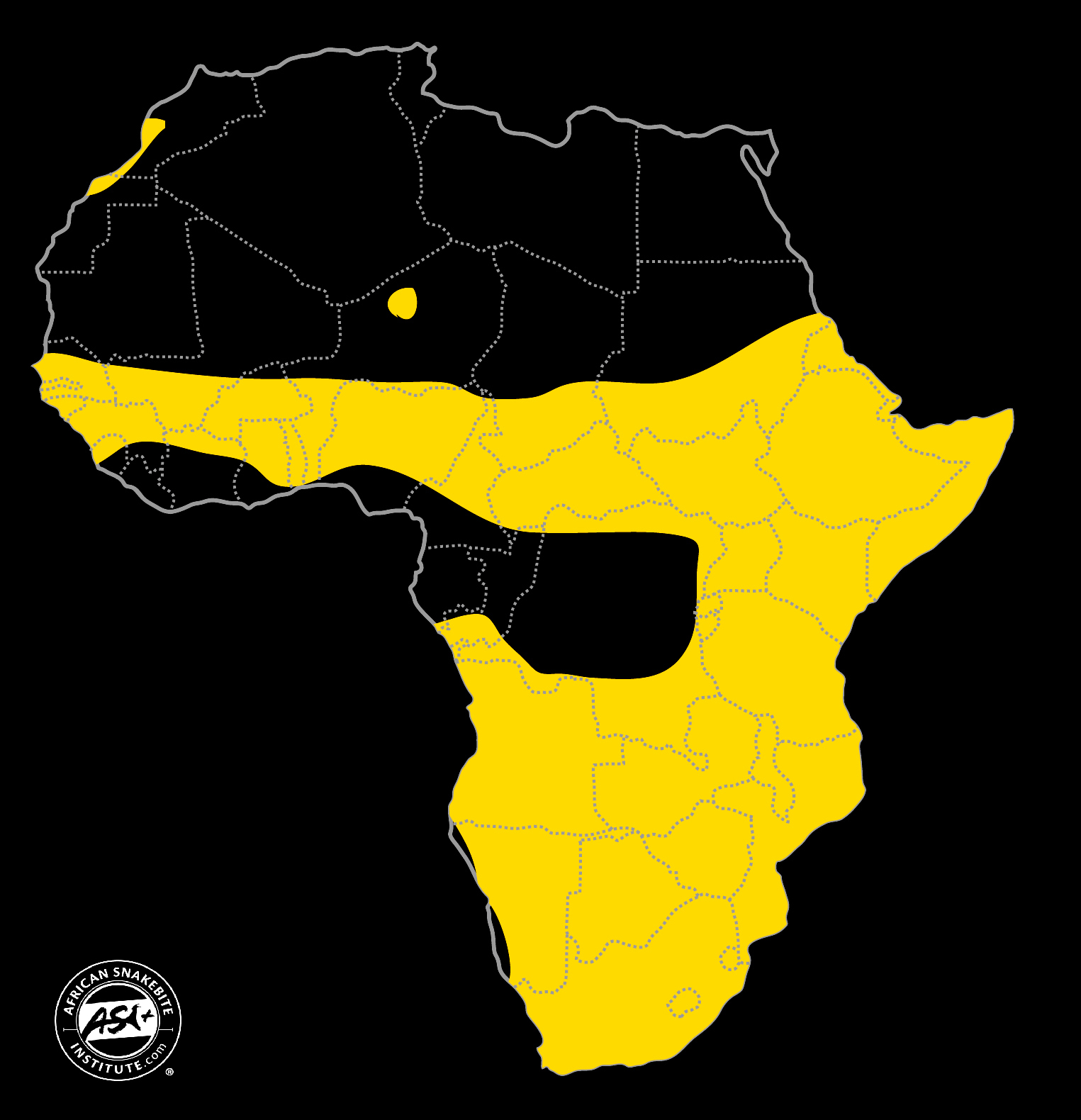 |
|
Puff Adders are widespread throughout Africa avoiding the thick jungles and true deserts.
|
|
|
|
Our A1 Medically Important Snakes of Southern Africa poster, covers 17 venomous snake species within the area.
With 4 color photographs per snake, a distribution map, what type of venom the snake has and which antivenom (if any) would be used to treat a bite.
(antivenom should only be used in a hospital environment, by trained medical professionals)
Price R25.00 each
|
|
|
| Order here |
|
|
|
A bite from a Puff Adder may result in instant pain, and swelling may start soon thereafter but this is not always the case. The swelling might take several minutes followed by progressive pain. In very severe bites the swelling may progress up a limb at a rate of more than 10 cm an hour. Blistering occurs after many hours and gets worse on the second and third day, and serious tissue damage may follow, but not always. Many Puff Adder bite victims experience some swelling which resolves in a few days and does not result in tissue damage.
|
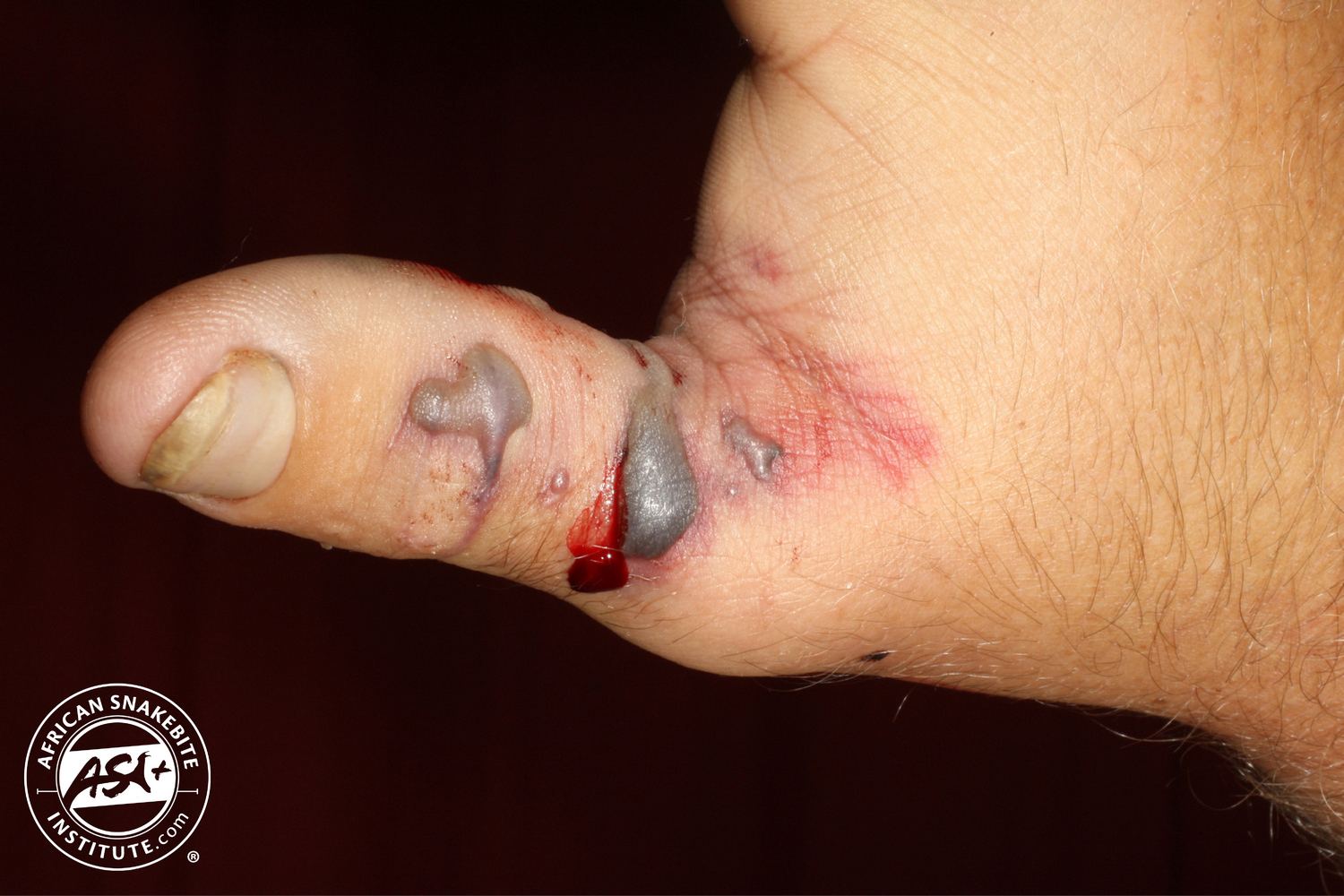 |
|
Blistering usually starts after a day or two.
|
|
|
|
It is surprising that so few people are bitten by this snake, as it is locally abundant. Prof Graham Alexander and the team at the Alexander Herp Lab at the University of Witwatersrand have done some amazing research on Puff Adders in Dinokeng Reserve north of Pretoria. Several Puff Adders were equipped with radio transmitters, and students followed and recorded their behaviour for several years. The most bizarre observation? These snakes are not difficult to find when they are camouflaged – they are invisible! Despite many years of field work in northern Gauteng, I have never encountered a Puff Adder in the field. Having said that, on certain nights when we do road surveys, we find many individuals crossing the road.
But there is more. While the students were studying Puff Adder behaviour, one or two of them accidentally stood on the Puff Adder they were trying to locate, but were not bitten. Prof. Alexander then designed an experiment using a gumboot filled with rocks. The gumboot was then bounced on the ground like a person walking and several camouflaged Puff Adders were ‘stood on’. Not a single snake hissed or bit. So it seems that Puff Adders in northern Gauteng, when ‘in camouflage mode’, are so convinced that they are invisible that they do not strike or hiss when stood on. This makes a lot of sense, as I have been doing snake talks to hunters for many years and have yet to meet a hunter that stood on a Puff Adder and got bitten. The hunting season is largely in winter, but in Gauteng Puff Adders mate until late June – and some of the males cover great distances seeking females.
|
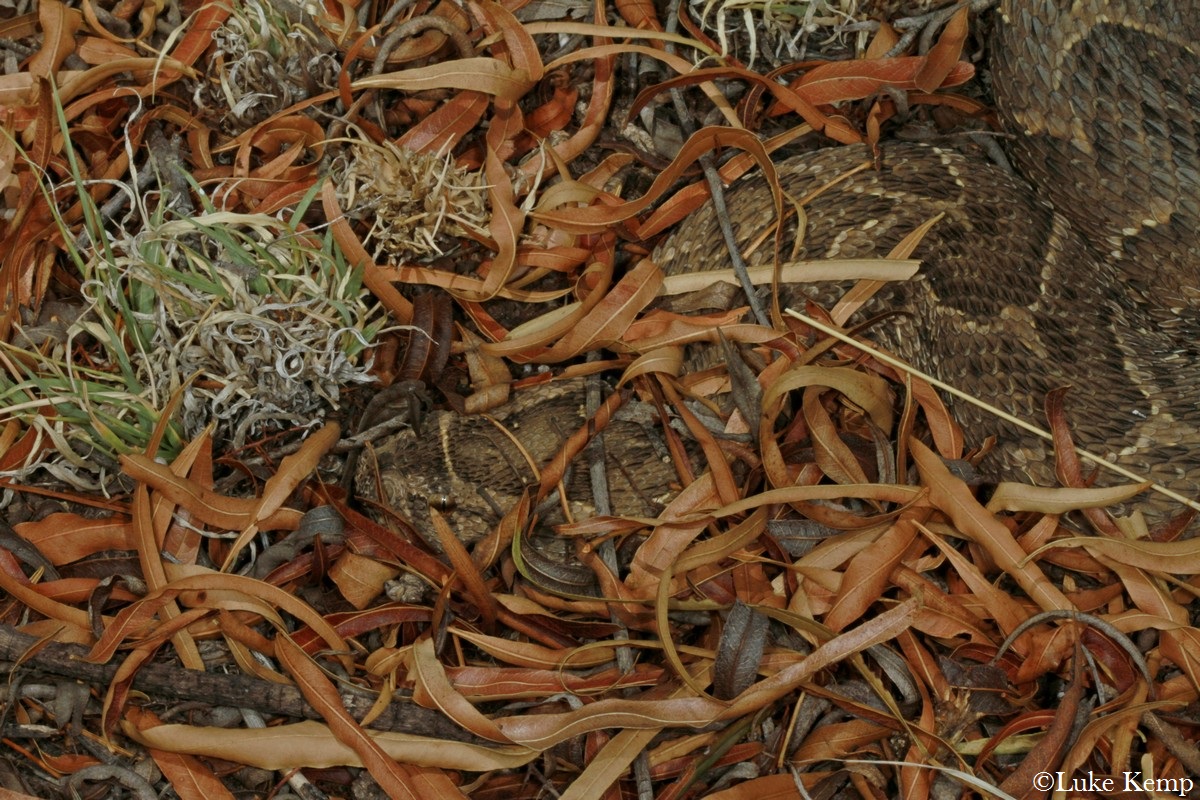 |
|
Puff Adders are incredibly well camouflaged.
|
|
|
|
The first of it's kind - A Southern African version of Snakes and Ladders, complete with local snakes and interesting facts.
Snakes and ladders board, 4 game pieces and dice included.
Price R29.00 each
|
|
|
| Order here |
|
|
|
It gets even more interesting – the next experiment by the Alexander Herp Lab was to train up dogs to find Puff Adders. This is nothing unusual, as dogs are often used to sniff out snakes and other reptiles such as tortoises. The sniffer dogs were quick to find snakes such as pythons, but could not find Puff Adders in camouflage mode. They then tried mongooses and even elephant but no joy – the Puff Adders, when camouflaged, seemed to emit no odor, making it extremely difficult for many predators to find them. Snouted Cobras – a common predator of the Puff Adder – on the other hand, seem to find Puff Adders readily and a number of the study animals ended up as meals. Yet lab tests showed the Snouted Cobras struggled to find Puff Adders by scent and seem to largely find them by sight, especially when Puff Adders where on the move.
During the Dinokeng study, Xavier Glaudas made use of video cameras while studying Puff Adder behaviour and he filmed a fascinating sequence where a Puff Adder was motionless at night when it spotted a toad bouncing past. The snake extended its tongue several times, moving it gently to emulate an insect. The toad changed direction, jumped closer and was eaten by the snake. This is the first observation of Puff Adders using their tongue to lure a toad closer.
|
|
|
|
Budget Snake Tongs
We stock a wide range of snake tongs – from entry level to our hugely popular JM range. We sell hundreds of tongs a month - both to corporate clients and to members of the public. It’s great to see how far snake awareness has spread – with many people now opting to catch and relocate the snake, rather than kill it. And to do so with proper equipment, instead of using braai tongs, noose sticks or their hands.
Our Budget Snake tongs are very popular with people who only do a few removals a year – but want to do so safely.
Price R625.00 each
|
|
|
| Order here |
|
|
|
When analyzing snakebite data, it seems that the majority of Puff Adder bites are from juveniles and subadults. That may be because these snakes are not well established and need to find a suitable home. Some adults will remain well camouflaged under a small shrub for several weeks at a time.
Dogs are natural hunters, and most dogs will attack a snake the moment they spot it. Long snakes such as cobras are grabbed at midbody and killed quickly by shaking the snake from side to side and snapping it into two pieces. This does not work well with Puff Adders, and they are quick to strike, invariably in or near the dog’s face.
In the event of a bite from a Puff Adder there is very little that one can do other than getting to the nearest hospital. Avoid tight bandages and all the other old wives’ tales like cutting and sucking out the venom or applying creams. Elevate the affected limb just above the heart to reduce pain and get to hospital. In serious bites doctors will administer polyvalent antivenom and the sooner it is done the better – antivenom does not reduce swelling or tissue damage – it neutralizes the venom in the body that would otherwise have spread far and caused damage as far as it could reach. In such bites, doctors usually start with an initial dose of 6 vials (60 ml) of polyvalent antivenom, and if symptoms do not improve, they may give more. As already mentioned, fatal bites are rare as the venom is slow-acting and, being a mixture of cytotoxins and haemotoxins, does not affect breathing.
|
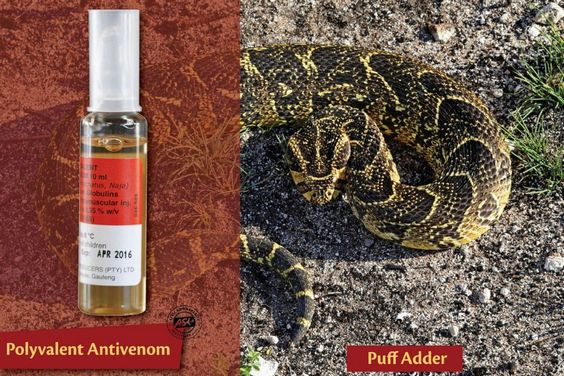 |
|
Early administration of Polyvalent antivenom will help reduce tissue damage.
|
|
In the event of a dog being bitten by a Puff Adder, one should get it to a vet with haste. It does not help to force milk or charcoal down its throat or to give the poor animal Allergex tablets – if it is a serious bite, the dog will need antivenom. Antibiotics, anti-inflammatories and Vitamin K do absolutely nothing to save the life of a dog and often worsen the situation.
Females give birth to between 20-40 young, but the most neonates recorded from a single birth was 156. The babies are 15-20 cm in length and adults rarely exceed 1,25 m in southern Africa but as much as 1,8 m elsewhere in Africa. The fangs of this snake may exceed 2 cm in length.
This snake may hiss or coil back into a striking position with its head pointing down when threatened, but if accidentally stood on at night or whilst the snake is on the move, there may be no warning. It is also one of the fastest striking snakes in Africa.
|
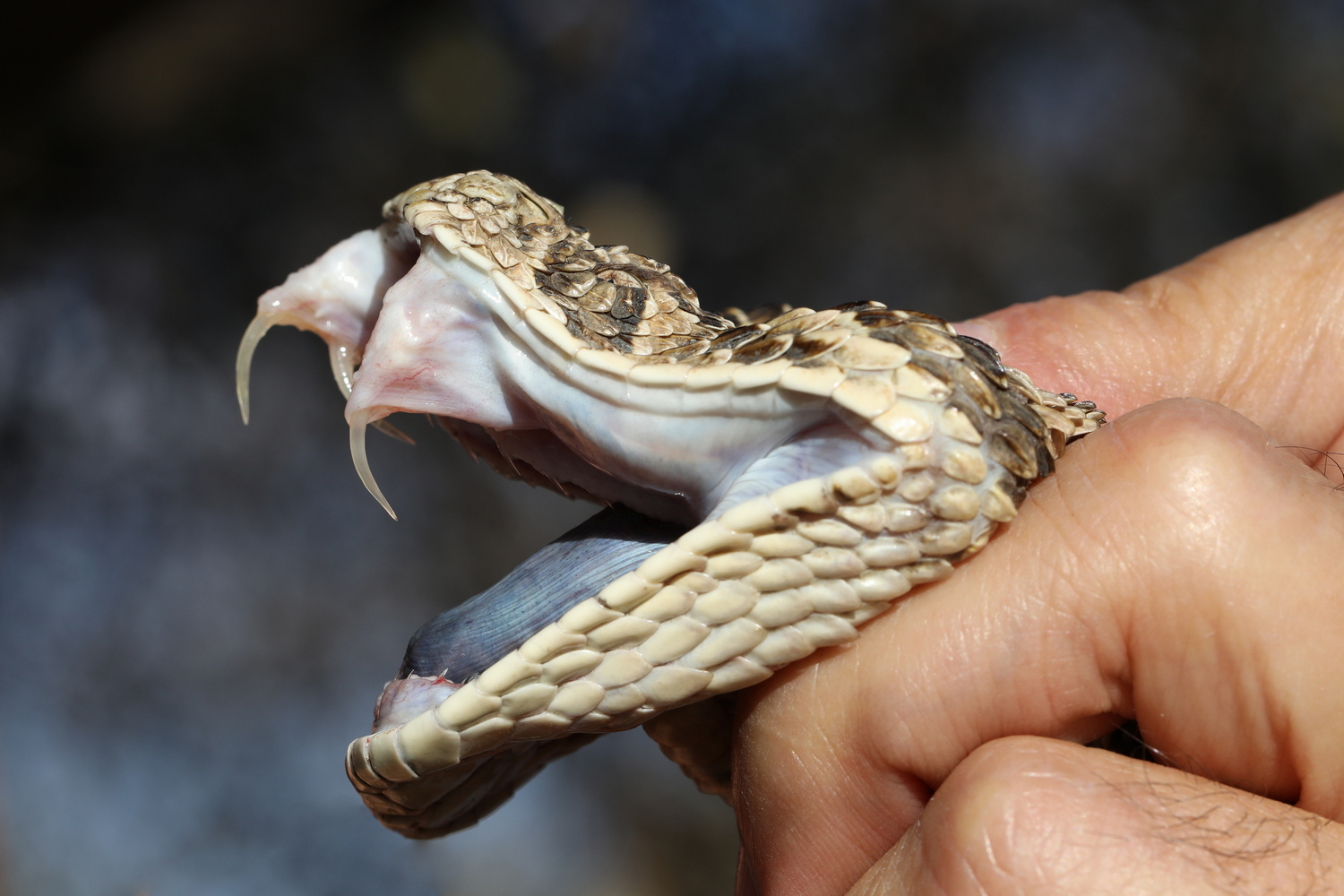 |
|
Puff Adder fangs may reach 2 cm in length! Photo Ashley Kemp.
|
|
|
|
The Dangerous Snakes of Africa is an indispensable guide to these reptiles. It covers all 137 dangerous snake species in Africa, along with another 70 species that are easily confused with them. All are described, with each account looking in detail at their identification, habitat and distribution, behaviour and venom, as well as how to treat bites and a selection of photographs.
This comprehensive book is an essential tool for all naturalists, conservationists, educators, field workers and medical personnel throughout Africa.
Price R795.00 each
|
|
|
| Order here |
|
|
|
|
|
|